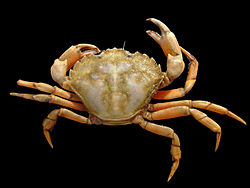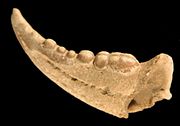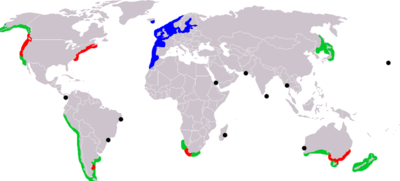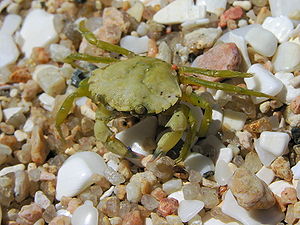
Carcinus maenas
About this schools Wikipedia selection
SOS believes education gives a better chance in life to children in the developing world too. SOS mothers each look after a a family of sponsored children.
| Carcinus maenas | |
|---|---|
 |
|
| Scientific classification | |
| Kingdom: | Animalia |
| Phylum: | Arthropoda |
| Subphylum: | Crustacea |
| Class: | Malacostraca |
| Order: | Decapoda |
| Suborder: | Pleocyemata |
| Infraorder: | Brachyura |
| Family: | Portunidae |
| Genus: | Carcinus |
| Species: | C. maenas |
| Binomial name | |
| Carcinus maenas (Linnaeus, 1758) |
|
Carcinus maenas is a common littoral crab, and an important invasive species. It is listed among the 100 "world's worst invasive alien species" .
C. maenas is known by different names around the world. In the British Isles, it is generally referred to simply as the shore crab. In North America and South Africa, it bears the name green crab or European green crab. In Australia and New Zealand, it is referred to as either the European green crab or European shore crab.
Description

C. maenas has a carapace up to 60 mm long and 90 mm wide , with five short teeth along the rim behind each eye, and three undulations between the eyes. The undulations, which protrude beyond the eyes are the simplest means of distinguishing C. maenas from the closely-related C. aestuarii, which can also be an invasive species. In C. aestuarii, the carapace lacks any bumps and extends forward beyond the eyes. Another character for distinguishing the two species is the form of the first and second pleopods (collectively the gonopods), which are straight and parallel in C. aestuarii, but curve outwards in C. maenas .
The colour of C. maenas varies greatly, from green to brown, grey or red. This variation has a genetic component but is largely due to local environmental factors . In particular, individuals which delay moulting become red–coloured rather than green. Red individuals are stronger and more aggressive, but are less tolerant of environmental stresses, such as low salinity or hypoxia .
Native and introduced range
C. maenas is native to European and North France coasts as far as the Baltic Sea in the east, and Iceland and central Norway in the north, and is one of the most common crabs throughout much of its range. In the Mediterranean Sea, it is replaced by the closely-related species Carcinus aestuarii.
C. maenas was first observed on the east coast of North America in Massachusetts in 1817, and may now be found from Nova Scotia to Virginia.
In Australia, C. maenas was first reported in the late 18th century, in Port Phillip Bay, Victoria. It has since spread along the coast of Victoria, reaching New South Wales in 1971, South Australia in 1976 and Tasmania in 1993. One specimen was found in Western Australia in 1965, but C. maenas has not been seen in the area since .
C. maenas first reached South Africa in 1983, in the Table Docks area near Cape Town . Since then, it has spread at least as far as Saldanha Bay in the north and Camps Bay in the south, over 100 km apart.
In 1989, C. maenas was found in San Francisco Bay, California, on the Pacific coast of the United States. Until 1993, it was not able to extend its range, but reached Oregon in 1997, the state of Washington in 1998 and British Columbia in 1999 .
In 2003, C. maenas was discovered in Patagonia .
Other appearances that have not, however, led to invasions have been recorded in Brazil, Panama, Hawaii, Madagascar, the Red Sea, Pakistan, Sri Lanka and Myanmar; Japan has been invaded by a related crab, either C. aestuarii or a hybrid of C. aestuarii and C. maenas .
It is believed, based on the ecological conditions, that C. maenas could eventually extend its range to colonise the Pacific coast of North America from Baja California to Alaska . Similar ecological conditions are to be found on many of the world's coasts, with the only large potential area not to have been invaded yet being New Zealand; the New Zealand government has taken action, including the release of a Marine Pest Guide in an effort to prevent colonisation by C. maenas.
Ecology
C. maenas can live in all types of protected and semi-protected marine and estuarine habitats, including habitats with mud, sand, or rock substrates, submerged aquatic vegetation, and emergent marsh, although soft bottoms are preferred. C. maenas is euryhaline, meaning that it can tolerate a wide range of salinities (from 4 to 52 ‰)and survive in temperatures from 0 °C to 30°C . The wide salinity range allows C. maenas to survive in the lower salinities found in estuaries.
A molecular biological study using the COI gene found genetic differentiation between the North Sea and the Bay of Biscay, and even more strongly between the populations in Iceland and the Faroe Islands and those elsewhere. This suggests that C. maenas is unable to cross deeper water .
Females can produce up to 185,000 eggs and larvae develop offshore in several stages before their final moult to juvenile crabs in the intertidal zone . Young crabs live in meadows of kelp, for instance Posidonia oceanica, until they reach adulthood.
C. maenas is a predator and feeds on many organisms, particularly bivalve molluscs (such as clams, oysters, and mussels), polychaetes and small crustaceans . They are primarily nocturnal, although activity also depends on the tide, and crabs can be active at any time of day .
C. maenas has the ability to disperse by a variety of mechanisms including: ballast water, ships' hulls, packing materials ( seaweeds) used to ship live marine organisms, bivalves moved for aquaculture, rafting, migration of crab larvae on ocean currents, and the movement of submerged aquatic vegetation for coastal zone management initiatives. Thresher et al. found that in Australia C. maenas dispersed mainly by rare long-distance events, possibly caused by human actions.
In California, preferential predation of C. maenas on native clams ( Nutricola spp.) resulted in the decline of the native clams and an increase of a previously introduced clam (the amethyst gem clam, Gemma gemma) . C. maenas has been implicated in the destruction of the soft-shell clam (Mya arenaria) fisheries on the east coast of the United States and Canada and the reduction of populations of other commercially important bivalves (such as scallops, Argopecten irradians, and northern quahogs, Mercenaria mercenaria) . The prey of C. maenas includes the young of bivalves and fish, although the effect of its predation on winter flounder, Pseudopleuronectes americanus is minimal . C. maenas can, however, have substantial negative impacts on local commercial and recreational fisheries by preying on the young of species such as oysters and the Dungeness crab, or competing with them for resources .
Control
Due to its potentially harmful effects on ecosystems, various efforts have been made to control introduced populations of C. maenas around the world. In Edgartown, Massachusetts, a bounty was levied in 1995 for catching C. maenas, in order to protect local shellfish, and 10 tons were caught .
There is evidence that the native blue crab in eastern North America, Callinectes sapidus, is able to control populations of C. maenas; numbers of the two species are negatively correlated, and C. maenas is not found in Chesapeake Bay, where Callinectes sapidus is most frequent . On the west coast of North America, C. maenas appears to be limited to upper estuarine habitats in part by predation by native rock crabs (Cancer antennarius and Cancer productus) and competition for shelter with a native shore crab, Hemigrapsus oregonensis . Host specificity testing has recently been conducted on Sacculina carcini, a parasitic barnacle, as a potential biological control agent of C. maenas . In the laboratory, Sacculina settled on, infected, and killed native California crabs, including the Dungeness crab, Cancer magister, and the shore crabs Hemigrapsus nudus, Hemigrapsus oregonensis and Pachygrapsus crassipes. Dungeness crabs were the most vulnerable of the tested native species to settlement and infection by the parasite. Although Sacculina did not mature in any of the native crabs, developing reproductive sacs were observed inside a few Cancer magister and Hemigrapsus oregonensis. Any potential benefits of using Sacculina to control C. maenas on the west coast of North America would need to be weighed against these potential non-target impacts .
C. maenas has also caused significant problems in the Republic of Ireland where predation of bottom-cultured mussels has been recorded in several counties ( Kerry, Wexford, Waterford), and a number of control programmes have been instigated by mussel producers. "Hard-eye" shrimp creels are typically used to fish C. maenas in Ireland; the creels are baited, deployed and fished in 24-hour cycles, being typically deployed in strings along the boundaries of mussel beds in order to lure the crabs out of the mussel beds. Some producers pay levies for the removal of crabs, but in most cases, C. maenas catches are sold for processing into food products. This is, however, a small market and the relatively low value of C. maenas (€500 per tonne) and high transport costs (refrigerated lorry €170 per tonne) means that fishing C. maenas is uneconomical unless it forms part of a control programme to protect more valuable shellfish beds .
Fishery
C. maenas is fished on a small scale in the north-east Atlantic Ocean, with approximately 1200 tonnes being caught annually, mostly in France and the United Kingdom. In the north-west Atlantic, C. maenas was the subject of fishery in the 1960s, and again since 1996, with up to 86 tonnes being caught annually .



